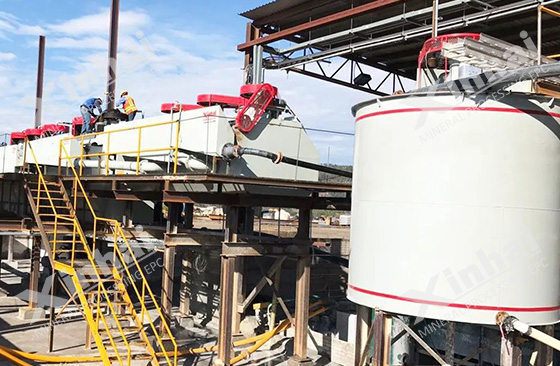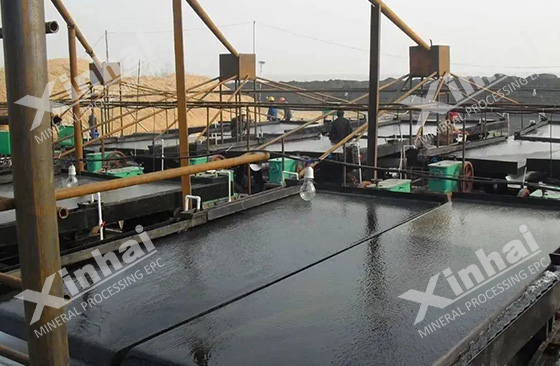
As an important source of metal resources, lead-zinc ore has economic and industrial value. With the continuous expansion of the use of lead-zinc ore, more and more attention has been paid to the development and utilization of lead-zinc ore resources. The beneficiation process of lead-zinc ore can be divided into four stages: grinding stage, sorting stage, product dehydration stage, and tailings treatment stage. In this article, we will start from the perspective of thelead-zinc ore beneficiation process and take stock of the various types of ore processing equipment used in the lead-zinc ore beneficiation process.

The crushing and grinding stage of lead-zinc ore can be divided into two parts: crushing and screening and grinding and classification. This stage determines the selected material particle size of lead-zinc ore, which is related to the smooth progress of subsequent lead-zinc ore beneficiation.
In the crushing process of lead-zinc ore, according to different technological processes, the crushing process adopted includes one-stage crushing and screening, two-stage one-closed-circuit crushing and screening and other processes. In the crushing stage, jaw crusher can be used for coarse crushing, cone crusher can be used for secondary crushing, and circular vibrating screen can be used for screening equipment.

Some lead-zinc mines are prone to produce slime, which may affect the beneficiation stage. According to the different properties of the lead-zinc ore, washing and desliming can be added to the crushing and screening. The ore washing equipment can use the ore washing screen, and the desliming equipment can use the spiral classifier.
In the process of grinding and classifying lead-zinc ore, one-stage closed-circuit grinding and classification and two-stage closed-circuit grinding and classification system can be used. According to the particle size composition of different lead-zinc ore, stage grinding stage separation process can also be adopted, with ball mill as the main grinding equipment and hydrocyclone as the classification equipment.
The beneficiation of lead-zinc ore is generally based on the flotation process. The selection process includes the priority flotation process of flotation of lead and zinc first, the mixed flotation process of lead-zinc mixed flotation and then separation, and the flotation of easy-to-float lead and zinc first and then the flotation of difficult-to-float lead and zinc. Flotation process, heavy-floating combined process, floating-magnetic combined process, etc.

In the selection of flotation equipment, various types of suction mechanical stirring flotation machines (SF type flotation machine, BF type flotation machine, JJF type flotation machine) and pneumatic mechanical stirring flotation machine (KYF type flotation machine) can be used. KYF flotation machine and XCF flotation machine), the combined unit composed of KYF flotation machine and XCF flotation machine can be considered. Among them, XCF is used as a suction tank, and KYF is used as a DC tank to achieve horizontal configuration without a foam pump.
Gravity separation and magnetic separation, as supplementary processes to improve the beneficiation index, can be added to the beneficiation process according to the beneficiation index of the specific ore. Among them, the gravity separation generally adopts a shaking table, and the magnetic separation generally adopts a permanent magnetic drum magnetic separator.

The filtration and dehydration stage of lead-zinc ore includes two parts: dehydration and filtration. It determines whether the demand for lead and zinc concentrates can be met. In the dehydration stage, a high-efficiency thickeneris generally used to dehydrate different types of concentrates.
In the filtration stage, the dehydrated concentrate can be further processed by using program-controlled hydraulic chamber filter press, ceramic vacuum filter, disc vacuum filter and other equipment to make it more in line with the water content requirements of the product.

For the tailings produced in the process of beneficiation of lead-zinc ore, the tailings are generally stored temporarily by means of dry tailings. It not only relieves the pressure on the storage capacity of the tailings pond, but also reduces the potential safety hazards of the tailings pond, and the use of backwater reduces the pressure of sewage treatment and saves the production and operation cost of the mine, which is also the requirement of the national green and environmental protection mine construction.

Taking the common lead-zinc mine tailings dry discharge process scheme - hydrocyclone + dewatering screen + filter press dewatering process as an example, this process uses hydrocyclone, dewatering screen and filter press as the main equipment, tailings The ore is transported by gravity or pump to the pump box of the rubber pump, pumped into the concentrated hydrocyclone group, and the underflow of the cyclone flows to the dewatering screen. to the thickener. The overflow of the cyclone flows to the thickener. After being concentrated, the filter press feed pump is used to feed the filter press into the filter press to be pressed into a filter cake, which is transported out of the workshop with a belt for storage. The buffer tank is then pumped to the thickener, the thickener overflows and flows to the return tank, and after clarification, it is pumped back to the processing plant for use.

The above are common lead-zinc beneficiation process equipment. In the actual dressing plant, the properties of lead-zinc ore are complex and diverse. The selection of lead-zinc ore dressing equipment and technological process should follow scientific and reasonable basis. Appropriate lead-zinc ore processing equipment and beneficiation process can achieve an ideal return on investment.
To find out more about our products and solutions, please fill out the form below and one of our experts will get back to you shortly.